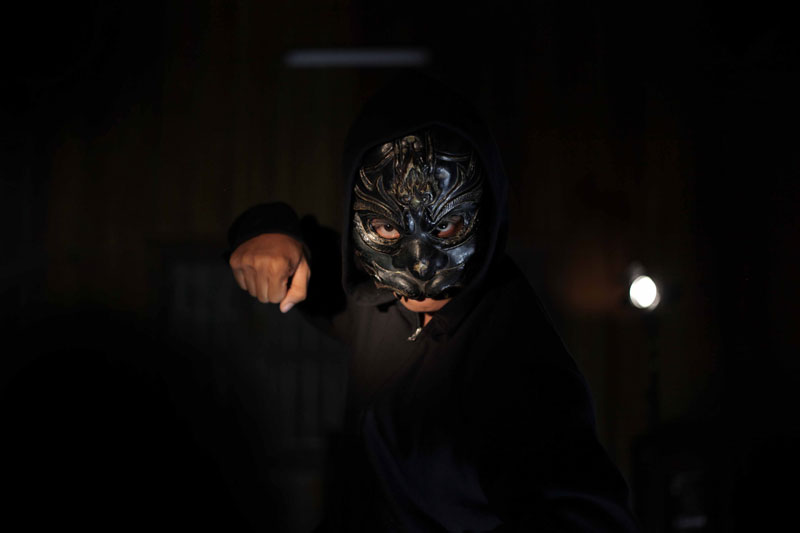Next weekend sees the release of Khmer-language action movie “Hanuman, Year of the Monkey,” bringing the country’s ancient bokator fighting style to the big screen for the first time in the tale of a young man raised in the countryside by a martial arts master, who returns to Phnom Penh to take brutal revenge on the gangsters that killed his father.
The movie is a passion project of Italian filmmaker Jimmy Henderson, whose cinematography on last year’s zombie flick “Run” gave the movie more polish than it probably deserved and convinced local production house Westec Media to give him free reign on “Hanuman,” on which he was producer, director, cinematographer, editor and co-writer.

The story opens with a prologue, as Vicheat (Dara Our) and his older brother Srong (Sopheakmith Ung) wander Phnom Penh’s mean streets, where they stumble upon a gang of youths in an alley torturing a dog. The younger brother tries to stop the attack, ignoring Srong’s warning that they are outnumbered to charge headlong into the fray.
Inevitably, he is wounded.
But Vicheat and his brother are soon thrust into the world of grown-ups, where violence and fear are the milieu and power is earned by an ability and willingness to inflict them. When charismatic mob boss Kim Veng (Savin Phillip) shows up at the boys’ home and demands their father repay a debt, he gives them a brutal lesson in the ways of the world, forcing them to watch their father be butchered because he begged for their safety—an offense to the philosophizing gangster’s corrupt sensibility.
Separated from his brother, Vicheat is brought up in the countryside by a wise old Mr. Miyagi figure, who hones his fighting skills and dispatches another gang of youths harassing a passerby on a bridge. Comparisons with the feel-good “Karate Kid” end there—when the old man dies, he leaves Vicheat a mask of a monkey god, a face for the dark side of his nature to wear as he charges headlong back into the fray.
The stage is now set to unleash bokator and a barrage of choreographed fight scenes ensues, culminating in increasingly violent and elaborate deaths as Vicheat battles his way through Kim Veng’s minions toward a final showdown with the boss.
There are unmistakable parallels with the 2012 action movie “The Raid”—a low-budget Indonesian movie helmed by Welsh expat Gareth Evans that wowed both critics and international audiences and put the country’s little known martial art pencak silat on the map.
Lightning is unlikely to strike twice. “Hanuman” was shot in less than two weeks and had a micro-budget significantly shy of “The Raid’s” estimated $1.1 million. But if the movie makes waves in Cambodia’s market, it will be a relative success on two fronts: financial and creative, as it must do battle with the conventions of the country’s established mainstream fare of saccharine romantic horror movies.
These cinematic duds have cornered the growing market here, leaving funders unwilling to stray from a proven formula that has virtually no appeal to the international film market—a phenomenon that renders commercial moviemaking self-limiting.
“Hanuman” might just break the loop. Opening on Valentine’s Day weekend, the movie is a provocative blend of violence and dark humor that should set pulses racing inside the city’s multiplexes.
It is an unabashedly populist genre film, but its dark themes, grimy atmosphere and surreal cinematography might startle audiences. The grotesque cast of characters—who are shot in extreme close-ups and distorted camera angles in a style that evokes Sergio Leone’s spaghetti westerns—and the extreme violence is the stuff of exploitation cinema, amplified to the point of parody.
In the lead role, Dara Our certainly has the looks to hook his audience and has the acrobatic martial arts chops to do a serviceable job with limited acting experience. The character lies somewhere in the conceptual space between “Conan the Barbarian,” “The Karate Kid” and “The Terminator,” though lacking the brawn, sympathetic quality or terrifying indomitability that makes those characters so memorable.
But the film knows its limitations. The mask that Vichea wears (becoming Hanuman) invokes his essential characterlessness and he is more a narrative hook on which to hang this surreal, hyper-violent portrait of contemporary Phnom Penh.
Nor do the fight sequences in Hanuman completely transcend their budgetary and time restrictions—without a professional stunt coordinator, some of the early confrontations feel cagey, as though the actors were worried they might actually hurt each other. But the near-perfect choreography of the film’s biggest set piece, a showdown free-for-all inside an abandoned warehouse, is well executed and the abundance of flying two-footed kicks should thrill domestic audiences.
The movie also has a clear subtext. It holds a mirror up to Cambodian society and reflects back a technicolored, carnivalesque nightmare that may or may not be an exaggeration, but there is no moral agenda.
This is a world conditioned by money and atrophied by the wants and needs that capitalism thrives on. The film’s greatest achievement, as is often the case, is its villains, who indulge the characteristics that make humans human and are more interesting than the good guys will ever be.
Savin Phillip chews up the screen as Kim Veng, the uber-villain who emerges as the film’s real antihero, a self-made man and paragon of success in his own eyes, who sees nothing conflicting about the violence it took to get there. His clearly articulated sense of entitlement extends to the opposite sex—at one point, we see him lying in bed with two buxom, scantily clad women in a scene funny enough that it is not as risque as it might have been.
With a cheeky, censor-skirting addiction to sniffing tiger balm, Kim Veng invokes any number of villains from Ben Kingsley in “Sexy Beast” to Al Pacino in “Scarface” and his pontificating dialogue echoes that archetype of 1980s American greed.
“Money is important. With it you are a king, without it? You may as well lie down in the street and die,” he tells the boys’ father, before sitting back to the sound of classical music while his henchman lie the victim down for him.
Kim Veng’s own son Phirun (Ma Chimmy), a pretty boy playing the tough guy, has one of the best and most fleeting scenes in the movie—riding daredevil on his motorbike through Phnom Penh with his girl at his back, the camera cuts to the pair at a fun park riding the merry-go-round, a perfect visual metaphor for the privileged, emasculated sons of powerful men.
The plot itself does lose a little momentum as Hanuman’s unquenchable thirst for revenge never quite convinces. But a memorable cast of supporting characters, including boxing legend Ei Phouthang as a hulking torturer known as “the Doctor,” keeps things engaging.
While it may not revolutionize Cambodian filmmaking, “Hanuman” should at the very least open its audience’s eyes to a more sophisticated kind of entertainment.



